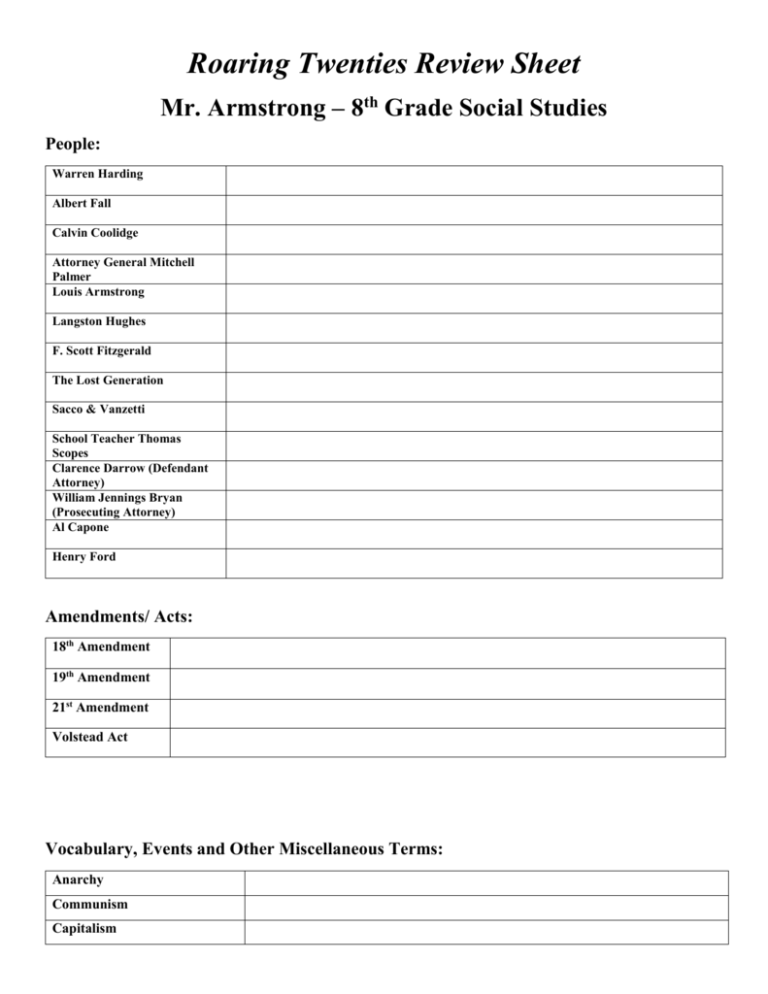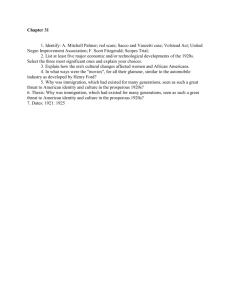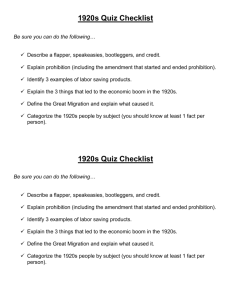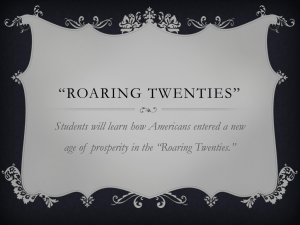Unit Review Sheet - Manhasset Public Schools
advertisement

Roaring Twenties Review Sheet Mr. Armstrong – 8th Grade Social Studies People: Warren Harding Albert Fall Calvin Coolidge Attorney General Mitchell Palmer Louis Armstrong Langston Hughes F. Scott Fitzgerald The Lost Generation Sacco & Vanzetti School Teacher Thomas Scopes Clarence Darrow (Defendant Attorney) William Jennings Bryan (Prosecuting Attorney) Al Capone Henry Ford Amendments/ Acts: 18th Amendment 19th Amendment 21st Amendment Volstead Act Vocabulary, Events and Other Miscellaneous Terms: Anarchy Communism Capitalism Laissez Faire Economics Red Scare Teapot Dome Scandal Nativism Installment Buying/ Credit Debt Assembly Line Mass Production Bootlegger Prohibition Speakeasy Sentiment Harlem Renaissance Jazz Flapper The Charleston Palmer Raids Assimilation Immigration Restriction Quotas Great Migration Isolationist Economic Prosperity Model T Creationism/ Fundamentalism Darwin’s Theory of Evolution Scopes/ Monkey Trial Sacco and Vanzetti Trial St. Valentine’s Day Massacre Examples of Household Appliances KKK Important Concepts & Ideas to Understand: Cities vs. Countryside/Rural Communities: These two locations vary in many ways and are symbolic of the differences in lifestyles during the 1920s. Cities were centers of new technology, new ideas, diversity, nativist sentiments, industry, factories, manufacturing and advertising. The cities of America in the 1920s represented a forward or new way of thinking for the time period. Major cultural, societal, political and economic changes could be witnessed throughout cities. The countryside or rural communities on the other hand, represented a more “traditional” way of life that was more closely aligned with religious principles. The countryside often represented communities that were not as willing or quick to accept the cultural changes that were taking place in America during the 1920s. Prohibition: Established by the 18th Amendment, prohibition made the making, sale and transportation of alcohol illegal. Prohibition was supported by some, especially women who had ties to the Temperance Movement of previous generations. However, more people opposed prohibition and wanted to have the opportunity to interact with alcohol. The people who opposed prohibition were predominantly those who lived in cities or urban settings. Both men and women engaged in the illegal sale and consumption of alcohol in the 1920s. Because this law was unpopular, enforcing the laws established in the Volstead Act became very difficult. The 18th Amendment was ultimately repealed by the creation of the 21 st Amendment which made alcohol legal. Nativism & Anti-Foreigner Sentiments: The notion that “true” Americans were those who were native-born to the United States was very evident during the 1920s. Nativists were people who thought that anyone not native-born to the United States were inferior to those who were native born. Nativism focuses on treating immigrants and foreigners as inferiors. This idea was on full display in the Sacco and Vanzetti Trial, and could also be seen when the government began to pass Immigration Restriction Acts that set quotas on the number of immigrants permitted to enter the United States. The Red Scare and the KKK were also symbolic of nativist sentiments. The “Old School” & “New School” Way of Thinking: The 1920s was filled with new ideas and approaches to topics and issues that had otherwise had a predominantly one-sided narrative. The new approaches and ways of thinking during the 1920s were influenced largely by science. This conflict of ideas and values was on full display in the Scopes Trial which represented the conflict between creationism/fundamentalism and Darwin’s theory of evolution. Many people living in the countryside were more aligned with traditional values and ideas that were associated with religion. People living in urban settings were typically more representative of newer approaches and beliefs to various topics or issues. A Consumer Economy: The United States economy during the 1920s was often categorized as a “consumer economy.” The reason for this was because Americans were purchasing or consuming more manufactured goods than any other time in American history up to that point. The assembly line and mass production allowed for more products to be made in a shorter period of time, and also lowered the cost of such products. Advertising, installment plans or buying on credit, also contributed to the consumer economy. Products were now more affordable and more desirable by the American public. Some of these new products included automobiles, household appliances like the refrigerator, vacuum, radio, toaster, as well as cigarettes, Coca-Cola, and other food or beverage related products. Many of the major companies or corporations were operating with little regulation or oversight from the Federal government. This practice of letting the economy essentially run itself is known as “laissez faire economics.” Both President Harding and Coolidge were proponents of such a system, as they felt that less government intervention would allow the economy to enjoy prosperity similar to how it had during WWI.





